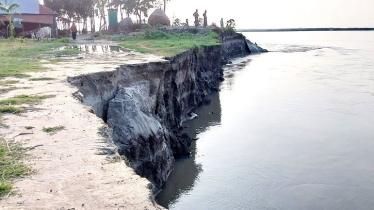
The devastating erosion of the Meghna River has destroyed more than 200 houses and structures in Boyarchar area of Char Gazhi Union under Ramgati upazila in Lakshmipur. As the river continues to devour the land, over fifty families have been displaced, taking shelter in open spaces after losing their homes and possessions. Thousands more live in constant fear of further erosion.
Residents recall that Boyarchar was once a bustling settlement of nearly 300,000 people, teeming with life and livelihood. Over the decades, the fierce river has consumed almost everything. A protective embankment built about two decades ago provided temporary relief, but it too eventually succumbed to the river’s force. This year’s monsoon season saw multiple breaches in the embankment stretching from Ramgati Bridge Ghat to Chairman Ghat. The collapse of the sluice gate area led to more than 200 homes being swallowed by the river. The Water Development Board (WDB) later placed geo-bags on an emergency basis to control the erosion temporarily.
Locals fear that unless permanent concrete blocks are installed before the next monsoon, the remaining parts of the embankment—and what little land remains—will also vanish into the river.
Seventy-year-old Saiful Islam, a lifelong resident of Boyarchar, said he has faced river erosion three times in his life. “The river used to be half a kilometer from my home. Now it touches my veranda,” he said. His two sons and four daughters are now living in uncertainty—some have taken refuge with relatives, while others have built makeshift shelters on government land.
Abdul Khalek, 80, another long-time resident, said he has lived in the char for four decades and lost his home to the river four times. “If it breaks again, I have nowhere else to go,” he said.
Rafiqul Islam, another villager, described the area’s dire condition: “Every day, the tide comes in and goes out. Roads, schools, and madrasas are disappearing. It feels like the river is swallowing our village.”
Md Didar, a member of Char Gazhi Union Parishad, warned that if a sustainable embankment is not built before the monsoon, the upazila’s map itself may change. “Once a densely populated area, Boyarchar will exist only as a memory of a lost land,” he said.
Local farmer Mokhlesur Rahman expressed his anguish, saying, “We are not just fighting river erosion—we are fighting for our existence, for our lives.”
Nahid Uzzaman Khan, Executive Engineer of the Lakshmipur Water Development Board, said river erosion in Boyarchar is not a new phenomenon but a long-standing issue. “The WDB has taken temporary measures at various times to help affected people,” he said. “For a permanent solution, Boyarchar has been included under the ‘Shobuj Pata Project.’ The project will cover around 10 kilometers of riverbank protection work. The proposal was submitted to the ministry last Thursday.”





